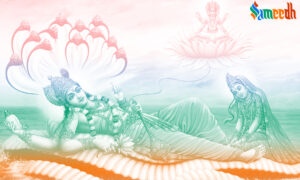In Hinduism, Narayan is one of the principal forms of the god Vishnu. Narayan is often depicted as reclining on the cosmic serpent Shesha, floating on the cosmic waters. This form of Vishnu is associated with the preservation and maintenance of the universe.

Narayan, in Hindu mythology, is a name often used to refer to Lord Vishnu, who is one of the principal deities in Hinduism and is considered the preserver of the universe. The term “Narayan” is derived from two Sanskrit words: “Nara,” which means human, and “Ayan,” which means resting place or refuge. Thus, Narayan can be interpreted as the ultimate refuge or resting place for all beings.
Narayan is often depicted in various forms and avatars in Hindu scriptures, including his famous incarnations as Ram and Krushna. He is typically portrayed with four arms, holding a conch shell (shankha), a discus (chakra), a mace (gada), and a lotus flower (padma). He is also commonly depicted reclining on the serpent Sheshnag, floating on the cosmic waters, in his form as Narayan. He is also addressed as Hari or Vasudeva on numerous occasions.
In Hindu mythology and scripture, Narayan is often described as the ultimate reality, beyond whom there is nothing else. He is considered the Supreme Being and the source of all other divine manifestations. Many Hindu scriptures, including the Vedas, Upanishads, and Purans, extol the greatness and significance of Narayan.
Devotees of Narayan worship him for his qualities of compassion, mercy, and protection. They offer prayers, perform rituals, and engage in devotional practices to seek his blessings and guidance in their lives. In Hindu mythology and scripture, the terms Narayan and Vishnu are often used interchangeably to refer to the same divine being. Devotees of Vishnu may address him by various names and epithets, including Narayan, to express their reverence and devotion towards him.
Narayan is a central figure in Vaishnavism, one of the major traditions within Hinduism, and his worship is widespread across India and other parts of the world where Hinduism is practiced. He is revered not only as a deity but also as the ultimate reality and source of all existence in Hindu cosmology.
Narayan, often identified with Lord Vishnu, has numerous stories and legends associated with him in Hindu mythology. Here are some of the popular Narayan stories:
- The Churning of the Ocean (Samudra Manthan): This is one of the most famous stories involving Narayan. Devas (celestial beings) and Asuras (demons) churned the ocean to obtain the nectar of immortality (amrita). Lord Vishnu, in his form as Kurma (turtle), supported Mount Mandara, which served as the churning rod, to prevent it from sinking. Ultimately, Vishnu helped the Devas obtain the amrita, ensuring their victory over the Asuras.
- The Dashavatar (Ten Incarnations): Narayan is believed to have taken ten major incarnations, known as the Dashavatara, to restore cosmic order and protect dharma (righteousness). These incarnations include Matsya (fish), Kurma (turtle), Varaha (boar), Narasimha (half-man, half-lion), Vamana (dwarf), Parashurama (sage with an axe), Rama (prince of Ayodhya), Krishna (cowherd and prince), Buddha, and Kalki (yet to come). Each incarnation has its own story and significance.
- The Ramayan: This epic tells the story of Lord Ram, an incarnation of Vishnu, and his journey to rescue his wife Sita from the demon king Ravan. The Ramayan is revered for its teachings on righteousness, devotion, and duty.
- The Mahabharat: This epic contains the Bhagavad Gita, a sacred dialogue between Prince Arjun and Lord Krushna, another incarnation of Vishnu. The Mahabharata narrates the Kurukshetra War between the Pandavs and the Kauravs and imparts profound philosophical teachings.
- The Bhagavat Puran (Srimad Bhagavatam): This scripture contains numerous stories about Lord Vishnu and his incarnations, as well as the exploits of his devotees. It includes the childhood pastimes of Krushna (Balkrushna) and his interactions with devotees like Sudama and the cowherd girls (gopis) of Vrindavan.
These are just a few examples of the rich tapestry of stories and legends associated with Narayan (Vishnu) in Hindu mythology. Each story carries deep philosophical, moral, and spiritual teachings for devotees to contemplate and derive inspiration from.